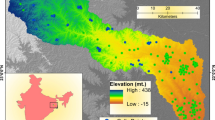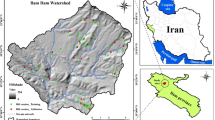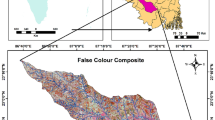Abstract
Soil erosion is one of the major environmental hazards causing severe land degradation in the sub-tropical monsoon dominated Mayurakshi river basin (MRB) of Eastern India. Hence, this study aims to delineate the areas with severe soil erosion probability (SEP) using logistic regression (LR), decision tree (DT), and Random forest (RF). A soil erosion inventory map was prepared using 150 rill and gully erosion prone sites, out of which 70% sample points were randomly chosen for modelling and remaining 30% sites were used for model validation. Alongside, 12 conditioning factors including elevation, curvature, aspect, runoff, TWI, slope, geology, stream frequency, rainfall erosivity, NDVI, LS-factor, and LULC were selected as spatial data base for model building. Multicollinearity among conditioning factors were performed using tolerance (TOL) and variance inflation factor (VIF). The analysis concludes that the possibility of soil erosion is very high in the undulating western parts of Mayurakshi river basin as compared to other sectors. The validation results obtained from ROC curve and kappa statistics is showing that DT and RF reached a higher prediction accuracy than LR model.








Similar content being viewed by others
References
Al-Juaidi AEM, Nassar AM, Al-Juaidi OEM (2018) Evaluation of flood susceptibility map** using logistic regression and GIS conditioning factors. Arab J Geosci 11:1–10
Amiri M, Pourghasemi HR, Ghanbarian GA, Afzali SF (2019) Assessment of the importance of gully erosion effective factors using Boruta algorithm and its spatial modeling and map** using three machine learning algorithms. Geoderma 340:55–69. https://doi.org/10.1016/j.geoderma.2018.12.042
Amiya G, Sunil S, Hamid RP (2019) Soil erosion Assessment using RUSLE model and its validation by FR probability model. Geocarto Int. https://doi.org/10.1080/10106049.2019.1581272
Arabameri A, Cerda A, Rodrigo-Comino J, Pradhan B, Sohrabi M, Blaschke T, Bui DT (2019a) Proposing a novel predictive technique for gully erosion susceptibility map** in arid and semi-arid regions (Iran). Remote Sensing 11:2577. https://doi.org/10.3390/rs11212577
Arabameri A, Pradhan B, Rezaei K (2019b) Gully erosion zonation map** using integrated geographically weighted regression with certainty factor and random forest models in GIS. J Environ Manage 232:928–932. https://doi.org/10.1016/j.jenvman.2018.11.110
Arabameri A, Pradhan B, Rezaei K, Yamani M, Pourghasemi HR, Lombardo L (2018) Spatial modelling of gully erosion using evidential belief function, logistic regression, and a new ensemble of evidential belief function–logistic regression algorithm. Land Degrad Dev 29:4035–4049. https://doi.org/10.1002/ldr.3151
Arora A, Pandey M, Siddiqui MA, Hong H, Mishra VN (2019) Spatial flood susceptibility prediction in Middle Ganga Plain: comparison of frequency ratio and Shannon’s entropy models. Geocarto Int. https://doi.org/10.1080/10106049.2019.1687594
Balasubramani K, Veena M, Kumaraswamy K, Saravanabavan V (2015) Estimation of soil erosion in a semi-arid watershed of Tamil Nadu (India) using revised universal soil loss equation (rusle) model through GIS. Model Earth Syst Environ. https://doi.org/10.1007/s40808-015-0015-4
Basu T, Pal S (2017) Identification of landslide susceptibility zones in Gish River basin, West Bengal. India Georisk 12(1):14–28
Chakrabortty R, Pal SC, Chowdhuri I, Malik S, Das B (2020) Assessing the importance of static and dynamic causative factors on erosion potentiality using SWAT, EBF with uncertainty and plausibility, logistic regression and novel ensemble model in a sub-tropical environment. J Indian Soc Remote Sens. https://doi.org/10.1007/s12524-020-01110-x
Chen W, Li Y, Xue W, Shahabi H, Li X, Hong H, Wang X, Bian H, Zhang S, Pradhan B, Ahmad BB (2019) Modeling flood susceptibility using data-driven approaches of naïve Bayes tree, alternating decision tree, and random forest methods. Sci Total Environ. https://doi.org/10.1016/j.scitotenv.2019.134979
Cheng L, Chen X, Vos JD, Lai X, Witlox F (2019) Applying a random forest method approach to model travel mode choice behavior. Travel Behav Soc 14:1–10. https://doi.org/10.1016/j.tbs.2018.09.002
Cohen M, Shepherd KD, Walsh MG (2005) Empirical reformulation of the universal soil loss equation for erosion risk assessment in a tropical watershed. Geoderma 124:235–252. https://doi.org/10.1016/j.geoderma.2004.05.003
Confort M, Aucelli PPC, Robustelli G, Scarciglia F (2011) Geomorphology and GIS analysis for map** gully erosion susceptibility in the Turbolo stream catchment (Northern Calabria Italy). Nat Hazards 56:881–898. https://doi.org/10.1007/s11069-010-9598-2
Conoscenti C, Angileri S, Cappadonia C, Rotigliano E, Agnesi V, Märker M (2013) Gully erosion susceptibility assessment by means of GIS-based logistic regression: a case of Sicily (Italy). Geomorphology. https://doi.org/10.1016/j.geomorph.2013.08.021
Dabral PP, Baithuri N, Pandey A (2008) Soil Erosion assessment in a hilly catchment of North Eastern India using USLE, GIS and remote sensing. Water Resour Manage 22:1783–1798. https://doi.org/10.1007/s11269-008-9253-9
Dharumarajan S, Hegde R, Singh SK (2017) Spatial prediction of major soil properties using Random Forest techniques—a case study in semi-arid tropics of South India. Geoderma Reg 10:154–162. https://doi.org/10.1016/j.geodrs.2017.07.005
Gayen A, Pourghasemi HR, Saha S, Keesstra S, Bai S (2019) Gully erosion susceptibility assessment and management of hazard prone areas in India using different machine learning algorithms. Sci Total Environ 668:124–138. https://doi.org/10.1016/j.scitotenv.2019.02.436
Ghosh S, Guchhait SK (2017) Estimation of geomorphic threshold in permanent gullies of lateritic terrain in Birbhum, West Bengal, India. Curr Sci 113(3):478–485. https://doi.org/10.18520/cs/v113/i03/478-485
Ghosh A, Dey P (2021) Flood Severity assessment of the coastal tract situated between Muriganga and Saptamukhi estuaries of Sundarban delta of India using Frequency Ratio (FR), Fuzzy Logic (FL), Logistic Regression (LR) and Random Forest (RF) models. Reg Stud Mar Sci. https://doi.org/10.1016/j.rsma.2021.101624
Ghosh A, Maiti R (2021) Development of new composite index on channel sensitivity using AHP, FR and ensemble model and its application on the Mayurakshi river of Eastern India. Int J River Basin Manage. https://doi.org/10.1080/15715124.2021.1879092
Gobinath R, Ganapathy GP, Akinwumi II, Prasath E, Raja G, Prakash T, Shyamala G (2020) Soil erosion protection on hilly regions using plant roots: an experimental insight. In: Shit PK, Pourghasemi HR, Bhunia GS (eds) Gully erosion studies from India and surrounding regions. Advances in science, technology & innovation. Springer Nature, Switzerland. https://doi.org/10.1007/978-3-030-23243-6
ICAR (Indian Council of Agricultural Research) (2013) State of Indian Agriculture, 2012–2013, A report of Department of Agriculture and Cooperation, New Delhi
Karan KS, Ghosh S, Samadder RS (2019) Identification of spatially distributed hotspots for soil loss and erosion potential in mining areas of Upper Damodar Basin—India. CATENA 182:104–144. https://doi.org/10.1016/j.catena.2019.104144
Khosravi K, Pham TB, Chapi K, Shirzadi A, Shahabi H, Revhaug I, Prakash I, Bui DT (2018) A comparative assessment of decision trees algorithms for flash flood susceptibility modeling at Haraz watershed, northern Iran. Sci Total Environ 627:744–755. https://doi.org/10.1016/j.scitotenv.2018.01.266
Low PS (2013) Economic and social impacts of desertification, land degradation and drought. White Paper I. UNCCD 2nd Scientific Conference, prepared with the contributions of an international group of scientists. https://profiles.uonbi.ac.ke/ jmariara/files/unccd_white_paper_1.pdf
Maloney KO, Weller DE, Russell MJ, Hothorn T (2009) Classifying the biological condition of small streams: an example using benthic macroinvertebrates. J N Am Benthol Soc 28(4):869–884. https://doi.org/10.1899/08-142.1
Meshram D, Gorantiwar SD, Wadne SS, Kumar KCA (2020) Planning, designing and construction of series of check dams for soil and water conservation in a micro-watershed of Gujarat, India. In: Shit PK, Pourghasemi HR, Bhunia GS (eds) gully erosion studies from India and surrounding regions. Advances in science, technology & innovation. Springer Nature, Switzerland
Meyer P, MartõÂnez-Casasnovas JA (1999) Prediction of existing gully erosion in vineyard parcels of the NE Spain: a logistic modelling approach. Soil Tillage Res 50:319–331
Ministry of Environment and Forestry (2011) Elucidation of the 4 National Report submitted to UNCCD Secretariat. Ministry of Environment and Forest. GOI 1–121. http://envfor.nic.in/sites/ default/files/unccdreport_0.pdf
Mondal S, Malnal S (2017) RS & GIS-based landslide susceptibility map** of the Balason River basin, Darjeeling Himalaya, using logistic regression (LR) model. Georisk 12(1):29–44
Nembrini S (2019) Prediction or interpretability? Emerg Themes Epidemiol. https://doi.org/10.1186/s12982-019-0086-1
Park S, Kim J (2019) Landslide susceptibility map** based on random forest and boosted regression tree models, and a comparison of their performance. Appl Sci 9:942. https://doi.org/10.3390/app9050942
Pham TG, Degener M, Kappas M (2018) Integrated universal soil loss equation (USLE) and geographical Information system (GIS) for soil erosion estimation in A Sap basin: Central Vietnam. Int Soil Water Conserv Res 6:99–110. https://doi.org/10.1016/j.iswcr.2018.01.001
Saha S, Gayen A, Pourghasemi HR, Tiefenbacher JP (2019) Identification of soil erosion-susceptible areas using fuzzy logic and analytical hierarchy process modeling in an agricultural watershed of Burdwan district, India. Environ Earth Sci 78:649. https://doi.org/10.1007/s12665-019-8658-5
Saha S, Roy J, Arabameri A, Blaschke T, Bui DT (2020a) Machine learning-based gully erosion susceptibility map**: a case study of Eastern India. Sensors 20:1313. https://doi.org/10.3390/s20051313
Saha S, Saha M, Mukherjee K, Arabameri A, Ngo PTT, Paul GC (2020b) Predicting the deforestation probability using the binary logistic regression, random forest, ensemble rotational forest, REPTree: a case study at the Gumani River Basin, India. Sci Total Environ 730:139–197. https://doi.org/10.1016/j.scitotenv.2020.139197
Sahana M, Patel P (2019) A comparison of frequency ratio and fuzzy logic models for flood susceptibility assessment of the lower Kosi River Basin in India. Environ Earth Sci. https://doi.org/10.1007/s12665-019-8285-1
Samad N, Chauhdry NH, Ashraf M, Saleem M, Hamid Q, Babar U, Tariq H, Farid MS (2016) Sediment yield assessment and identification of check dam sites for Rawal Dam catchment. Arab J Geosci 9:466. https://doi.org/10.1007/s12517-016-2484-9
Samanta S, Pal DK, Palsamanta B (2018) Flood susceptibility analysis through remote sensing, GIS and frequency ratio model. Appl Water Sci. https://doi.org/10.1007/s13201-018-0710-1
Sardá-Espinosa A, Subbiaha S, Bartz-Beielsteinb T (2017) Conditional inference trees for knowledge extraction from motor health condition data. Eng Appl Artif Intell 62:26–37. https://doi.org/10.1016/j.engappai.2017.03.008
Senapati U, Das TK (2020) Assessment of potential land degradation in Akarsa watershed West Bengal using GIS and multi-influencing factor technique. In: Shit PK, Pourghasemi HR, Bhunia GS (eds) Gully erosion studies from India and surrounding regions. Advances in science technology & innovation. Springer Nature, Switzerland
Singh G, Babu R, Narain P, Bhushan LS, Abrol IP (1981) Soil loss prediction research in India. Bull. No. T-12/D-9, Central Soil and Water Conservation Research Training Institute, Dehradun.
Tehrany MS, Pradhan B, Jebur MN (2013) Spatial prediction of flood susceptible areas using rule-based decision tree (DT) and a novel ensemble bivariate and multivariate statistical models in GIS. J Hydrol 504(11):69–79
Tehrany MS, Shabani F, Jebur MN, Hong H, Chen W, **e X (2017) GIS-based spatial prediction of flood prone areas using standalone frequency ratio, logistic regression, weight of evidence and their ensemble techniques. Geomat Nat Haz Risk 8(2):1538–1561
Zhu M (2014) Soil erosion assessment using USLE in the GIS environment: a case study in the Danjiangkou Reservoir Region, China. Environ Earth Sci. https://doi.org/10.1007/s12665-014-3947-5
Acknowledgements
The authors are sincerely grateful to the Department of Geography of the Vidyasagar University, Midnapore, West Bengal, India, Dr. D. S. Kothari Post Doctoral Fellowship—UGC and DST-FIST for providing necessary supports and opportunity to prepare this research work. We are also thankful to all the esteemed reviewers and editor for their valuable suggestions and guidance.
Funding
No funding was received from any agency for conducting this research.
Author information
Authors and Affiliations
Contributions
AG: Research design, map**, statistical analysis, and writing. Professor RM: framework, editing, and organization.
Corresponding author
Ethics declarations
Conflict of interest
The authors declare that they have no conflict of interest.
Additional information
Publisher's Note
Springer Nature remains neutral with regard to jurisdictional claims in published maps and institutional affiliations.
Rights and permissions
About this article
Cite this article
Ghosh, A., Maiti, R. Soil erosion susceptibility assessment using logistic regression, decision tree and random forest: study on the Mayurakshi river basin of Eastern India. Environ Earth Sci 80, 328 (2021). https://doi.org/10.1007/s12665-021-09631-5
Received:
Accepted:
Published:
DOI: https://doi.org/10.1007/s12665-021-09631-5




